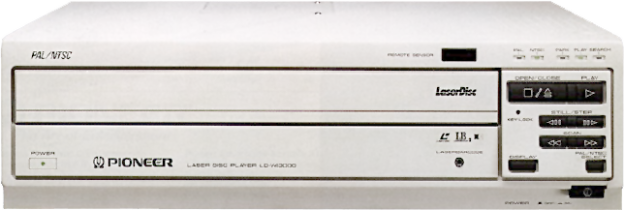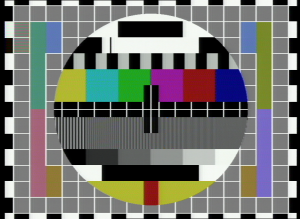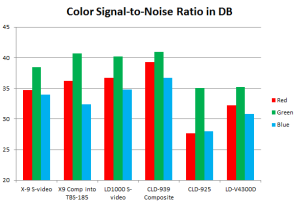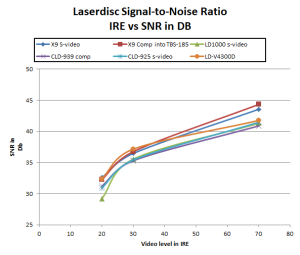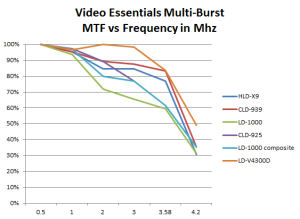The Pioneer LD-V4300D is a single-sided industrial PAL/NTSC Laserdisc player. Given the mediocre results of my testing the CLD-925D I wanted a better PAL player. I’d heard good things about both the CLD-2950 and LD-V4300D, but the CLD-2950 is getting a bit long in the tooth.
Since the LD-V4300D is an industrial model, and was made until very late in the Laserdisc lifecycle, I thought it might be a better bet, longevity wise.
The Player
If you’ve only handled PAL consumer players, then the LD-V4300D is certainly sturdy, clocking in at 12.6 kg compared to the 6.8 kg of the CLD-D925. Rear connectivity includes:
- Switchable 220v/120v power input (which works fine with 100v Japanese power)
- EXT sync input and output (you are unlikely to ever use this)
- Serial RS232 socket (D-sub 15)
- Composite video BNC and phono
- RGB D-SUB9 connector
- Stereo audio phono
- EFM DIN style socket (for LD-ROM data)
My unit came with no remote, although any Pioneer standard Laserdisc remote will operate the player. Unlike most 1990s players the LD-V4300D is a single-side only player, this means flipping the disc manually to play the B-side. Mechanically and electronically this allows the player to be simpler.
The RGB output is interesting, but pointless: the comb filter inside the player is extremely primitive, even the most basic modern 2D comb-filter would out perform it. The two composite outputs are apparently identical.
Paging through the service manual a few choice nuggets are revealed:
- The video demodulation block is almost the same as the CLD-1450 (which is the European version of the CLD-100)
- The player uses CCD based delay blocks (Including a Sony CXL1009 based TBC)
- The NTSC/PAL -> RGB decoder is a Sony V7021, also used in the Commodore Amiga
When I first starting using the player, it would get stuck in an endless loop in the first few minutes of a CAV disc. Opening up the powered-down player (be very careful of the laser), and manually moving the laser head backwards and forwards across its rails a few times cured this problem.
LD-V4300D Subjective Performance
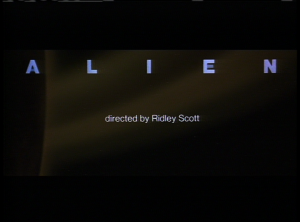
The Pioneer LD-V4300D Laserdisc playing spinning the THX Alien NTSC disc. Ghosting and CLV smear aplenty.
Okay, not great. The ghosting is noticeable on high contrast sequences like title and credit sequences, and the image has quite a gritty look, that is probably representative of the image recorded on the disk.
Dropouts seemed quite noticeable compared to other players I’ve looked at, so be warned. The picture is very much warts and all.
CAV pause showed some time-base instability that caused artifacts in paused test patterns. And trick play (fast forward/reverse) showed some time base disturbance.
LD-V4300D Measurements
All test recordings were taken through a Snell and Wilcox TBS-185 using the ‘Golden Gate’ 3D composite decoder, then captured over a SDI link to a Hyperdeck Shuttle losslessly. Signal to noise ratios are calculated using greyscale and color-bar patches, and measuring standard deviation from mean. Frequency responses are measured using multi-burst pattern from video essentials (played not paused), and amplitude response is measured using the scopes in Adobe After Effects.
NTSC frequency response is excellent with very flat response out to 4Mhz. Luma noise is within the upper part of the same tight band that other players inhabit. Chroma noise is a little disappointing, but I attribute this to a lack of any analogue chroma noise reduction processing in the player. Watching a single CAV frame in pause reveals the noise pattern holds steady
The title sequence of ‘Alien‘ confirmed that the LD-V4300D exhibits CLV smear. My setup also showed ghosting, which may be a cabling or impedance issue, but isn’t one that I’ve seen on other players.
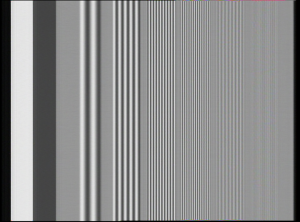
A video essentials NTSC multi-burst played through an LD-V4300D laserdisc player. A very flat response.
The LD-V4300D Compared To Other Players
Official performance figures are:
Signal-to-noise ratios:
48 dB (NTSC) / 43 dB (PAL)
Frequency reponse:
4.1MHz, -6dB (NTSC) / 4.8MHz, -6db (PAL)
Horizontal resolution:
420 lines (NTSC) / 435 lines (PAL)
Measuring NTSC and PAL signal-to-noise ratios I get about 7 dB below the spec numbers for both NTSC and PAL, though this is most likely due to the nature of my measuring technique of using a grey-scale and measuring deviation from mean signal level on the PAL CAV edition of ‘Jason and the Argonauts’ and the NTSC ‘Video Essentials’.
Conclusions
Three out of five. The LD-V4300D is an okay PAL player (against feeble competition), but doesn’t cut it in the NTSC high end. On the plus side its it has the flattest NTSC frequency response of any player I’ve measured. However chroma-noise reduction is nothing to write home about and the ghosting issues are a major drawback. It’s possible the ghosting is a fault with my player rather than a general fault with the design, given the age of the unit (17 years!) it is entirely possible, if you remove the ghosting from the equation, then you have a very nice PAL player that easily surpasses the not-very-high bar set by the CLD-D925.
With respect to NTSC performance. My recommendation is still to get a CLD-97, or a player from that family like the CLD-939 or 959. If money is no object, then a HLD-X9 is certainly worth a look due to the lack of CLV smear. I have yet to review a HLD-X0, if someone has one – and a copy of video essentials, it would be trivial for me to add it to the above comparison.
I’ll try and track down a CLD-2950 to review, though it may have to wait until next year.

